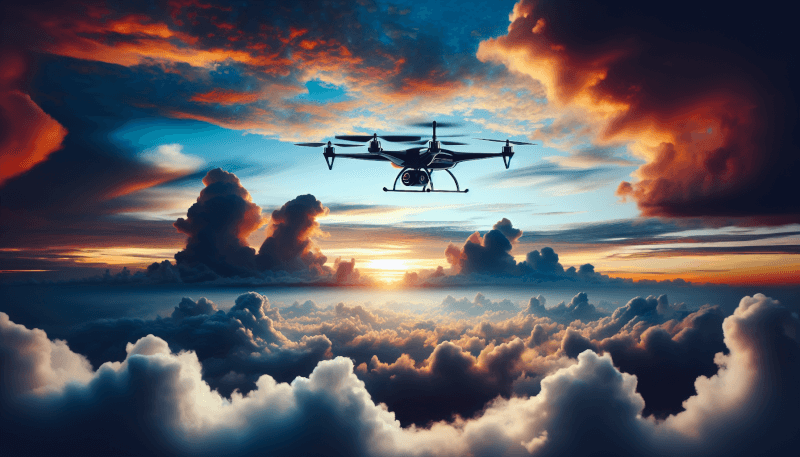Have you ever wondered how high an RC helicopter or quadcopter can fly? It’s a question that sparks curiosity among RC enthusiasts and beginners alike. In this article, we will explore the thrilling heights that these remote-controlled flying machines can reach. We’ll dive into the technical aspects, discuss the factors affecting altitude, and showcase some jaw-dropping records achieved by skilled pilots. So strap in and get ready for a thrilling journey into the skies!

Factors that determine the maximum altitude
When it comes to determining the maximum altitude an RC helicopter or quadcopter can reach, several factors come into play. These factors include the power source, weight and size of the aircraft, motor power, rotor blade design, weather conditions, air density, control range, altitude limitations, battery capacity, and the pilot’s flying experience. Let’s delve into each of these factors and understand how they affect the maximum altitude achievable by these remote-controlled aircraft.
Power source
The power source of an RC helicopter or quadcopter plays a significant role in determining its maximum altitude. There are two main types of power sources for these aircraft – electric-powered and gas-powered. Electric-powered RC helicopters and quadcopters generally have limitations when it comes to reaching higher altitudes compared to their gas-powered counterparts. This is because gas-powered engines provide more sustained power and thrust, allowing the aircraft to climb higher.

Weight and size
The weight and size of an RC helicopter or quadcopter will also impact its maximum altitude. As the weight of the aircraft increases, it requires more power to lift off and maintain altitude. Therefore, heavier aircraft may struggle to reach higher altitudes compared to lighter ones. Similarly, the size of the aircraft can affect its maximum altitude. Larger aircraft tend to have more surface area, creating more drag and requiring additional power to counteract its effects.
However, it is essential to note that weight and size can also have trade-offs. While reducing the weight of the aircraft may allow it to reach higher altitudes, it might compromise its stability and durability. Likewise, reducing the size of the aircraft might enhance its maneuverability but can limit its payload capacity, thus affecting its maximum altitude.
Motor power
The motor power of an RC helicopter or quadcopter is another crucial factor in determining its maximum altitude. The power output of the motor directly affects the thrust generated by the aircraft, enabling it to climb higher. Brushless motors are generally preferred over brushed motors as they provide higher power efficiency and better performance. Quadcopters and helicopters equipped with brushless motors have a greater chance of reaching higher altitudes due to their increased power output.

Rotor blade design
The design of the rotor blades greatly influences the maximum altitude an RC helicopter or quadcopter can achieve. Several aspects of the rotor blade design come into play, including blade length and pitch, the number of rotor blades, and the quality and material used for construction.
Longer rotor blades generally generate more lift, allowing the aircraft to ascend to higher altitudes. Similarly, blades with a steeper pitch angle can provide increased thrust, facilitating better climbing capabilities. Additionally, having multiple rotor blades can increase stability, but it may also increase the overall weight of the aircraft, potentially impacting its maximum altitude.
The quality and material of the rotor blades are also crucial. Stiffer and more rigid blades can provide better aerodynamic performance, improving the maximum altitude achievable. Carbon fiber blades are often favored due to their lightweight and strong characteristics.
Weather conditions
Weather conditions play a significant role in the maximum altitude an RC helicopter or quadcopter can reach. Wind, temperature, humidity, and precipitation can all affect the performance and altitude capabilities of these aircraft.
High winds can impose restrictions and pose risks to the stability and control of the aircraft. Strong gusts of wind can prevent the aircraft from climbing to its maximum altitude or even cause it to lose control. Therefore, it is essential to consider the wind conditions and avoid flying in excessively windy conditions.
Temperature and humidity levels can also impact the aircraft’s maximum altitude. Hotter temperatures and high humidity can reduce the air density, making it less conducive for the aircraft to generate lift. Conversely, colder temperatures and lower humidity levels can improve air density, potentially allowing the aircraft to reach higher altitudes.
When it comes to precipitation, such as rain or snow, it is advisable to avoid flying altogether. Moisture can interfere with electronic components and compromise the stability and control of the aircraft, posing a safety risk.

Air density
Air density directly affects the maximum altitude an RC helicopter or quadcopter can achieve. As the altitude increases, the air density decreases, which affects the ability of the aircraft to generate lift. Lower air density reduces the efficiency of the rotor blades, resulting in a decrease in lift force and limiting the altitude attainable by the aircraft.
Altitude limitations may come into play as air density decreases, especially at higher elevations. Therefore, it is crucial to consider the air density and its impact on the aircraft’s performance and maximum altitude, particularly when flying at high altitudes.
Control range
The control range of an RC helicopter or quadcopter can also influence its maximum altitude. The connection range between the transmitter and the aircraft can impose limitations on how high the aircraft can be flown. If the control range is limited, it may prevent the aircraft from ascending to its maximum possible altitude.
Additionally, potential interference from other electronic devices or radio signals could affect the control range and subsequently restrict the aircraft’s altitude capabilities. It is important to ensure a clear and uninterrupted communication channel between the transmitter and the aircraft to avoid any limitations in altitude.
Altitude limitations
Apart from the physical factors that impact maximum altitude, there may also be regulatory restrictions and safety concerns that impose altitude limitations on RC helicopters and quadcopters. Various countries and regions have established rules and regulations governing the use of these aircraft, particularly when it comes to their altitude capabilities. It is important to adhere to these regulations to ensure safety and avoid any legal complications.
Pilots are also encouraged to follow recommended safety practices to ensure safe flying. This includes avoiding flying in crowded areas or near airports and maintaining visual sight of the aircraft at all times. Being mindful of one’s surroundings and the potential risks associated with flying at high altitudes is essential for a safe and enjoyable flying experience.
Battery capacity
The battery capacity of an RC helicopter or quadcopter can affect the maximum altitude achievable by the aircraft. A higher capacity battery can provide more power and longer flight times, enabling the aircraft to climb to higher altitudes. Conversely, a lower capacity battery might limit the aircraft’s climbing capabilities and reduce the maximum altitude it can reach. It is important to choose a battery with an appropriate capacity that aligns with the desired altitude goals.
Flying experience
The pilot’s flying experience and skill level also play a role in the maximum altitude attainable by an RC helicopter or quadcopter. A skilled pilot with a deep understanding of flight dynamics and control techniques will be able to optimize the aircraft’s performance and push its limits. In contrast, a less experienced pilot may struggle to reach the maximum altitude potential of the aircraft due to inadequate control or suboptimal flight techniques.
Investing time and effort in developing flying skills and knowledge can greatly enhance the overall flying experience and potentially allow the pilot to push the aircraft to higher altitudes within safe and reasonable limits.
In conclusion, several factors influence the maximum altitude that an RC helicopter or quadcopter can reach. These factors include the power source, weight and size of the aircraft, motor power, rotor blade design, weather conditions, air density, control range, altitude limitations, battery capacity, and the pilot’s flying experience. By considering and optimizing these factors, enthusiasts can strive to achieve higher altitudes with their remote-controlled aircraft while ensuring safety and adhering to regulations. Remember to always prioritize safety and follow local laws and regulations for a rewarding and enjoyable flying experience.


